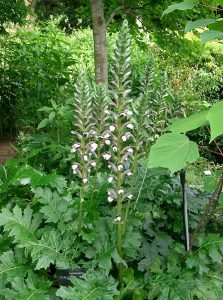 The ancient Greeks admired the large deeply lobed and cut leaves of this tender herbaceous perennial and used it as a model for the decorative capitals on their Corinthian columns. Also called sea dock, bearsfoot, and oyster plant, it is a member of the mostly tropical family, Acanthaceae, that also includes polka dot plant, shrimp plant, and Thunbergia. It is native of the Mediterranean from Greece to Portugal, and grow especially well in Southern California where the climate is hot and dry like its native range. There it blooms during the summer with tall flower shoots covered with up to 120 tubular pinkish-white florets complemented by mauve hoods and subtended by three green to purplish bracts. Broadleaved bears breeches can be grown in zones 8 to 10 (with protection in 7) but in colder areas may not bloom and is grown for the large attractive leaves. The foliage declines after flowering and some gardeners remove the flower spikes as they emerge to keep the foliage looking good. The cultivar ‘Latifolius” is hardier than the species. The genus name Acanthus, comes from the Greek word akanthos meaning thorn or prickle and refers to the spines on the leaves of some species. The specific epithet, mollis, is the Latin word meaning smooth and refers to the lack of spines on the leaves.
The ancient Greeks admired the large deeply lobed and cut leaves of this tender herbaceous perennial and used it as a model for the decorative capitals on their Corinthian columns. Also called sea dock, bearsfoot, and oyster plant, it is a member of the mostly tropical family, Acanthaceae, that also includes polka dot plant, shrimp plant, and Thunbergia. It is native of the Mediterranean from Greece to Portugal, and grow especially well in Southern California where the climate is hot and dry like its native range. There it blooms during the summer with tall flower shoots covered with up to 120 tubular pinkish-white florets complemented by mauve hoods and subtended by three green to purplish bracts. Broadleaved bears breeches can be grown in zones 8 to 10 (with protection in 7) but in colder areas may not bloom and is grown for the large attractive leaves. The foliage declines after flowering and some gardeners remove the flower spikes as they emerge to keep the foliage looking good. The cultivar ‘Latifolius” is hardier than the species. The genus name Acanthus, comes from the Greek word akanthos meaning thorn or prickle and refers to the spines on the leaves of some species. The specific epithet, mollis, is the Latin word meaning smooth and refers to the lack of spines on the leaves.
Type: Herbaceous perennial
Bloom: Tall spikes, 4-6’ in height, of pinkish white florets have mauve hoods; June-August
Foliage: Leaves 24’long by 12” wide form 36-48” clump.
Size: 3-6’H x 4’W
Light: Partial shade to full sun
Soil: Light, sandy, well-drained, alkaline
Hardiness: Zones 8-10, 7 with protection
Care: Remove flower stalks for more attractive foliage
Pests and Diseases: Slugs and snails
Propagation: Division in winter
Companion plants: Bamboo, ornamental grasses, large ferns.
Photo Credit Kenpei Wikimedia Commons
